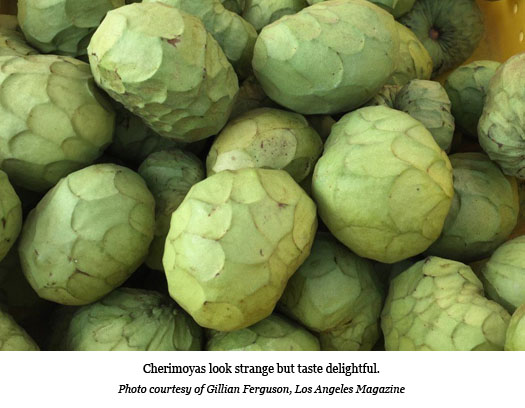by Gillian Ferguson, Los Angeles Magazine
If there were a contest for the weirdest fruit at the farmers’ market, cherimoyas would take home the gold. The name alone is a hurdle, and then there’s the fruit itself. The skin is at once bright and murky, like an old lime-green Seahawks jersey after a particularly muddy game. The exterior is cloaked in what looks like scales, each one the size of a thumbprint. There are cherimoyas the size of baseballs and there are cherimoyas the size of bowling balls. The custard-like flesh is milky white and flecked with giant black seeds that when extruded carefully leave behind a structure resembling swiss cheese.

I’ve heard the flavor described as mango, pineapple, papaya, banana, apple, pear, and vanilla, but not all at one time. The most apt description came from Shiho Yoshikawa, the ice cream savant behind Sweet Rose Creamery, who compares it to Juicy Fruit gum.
Aside from eating it out of your hand, the most obvious application of cherimoyas is ice cream, largely because of the texture that falls somewhere between a ripe avocado and a perfectly set flan. At Sweet Rose, Yoshikawa waits until the fruit is dead ripe before spinning it into sorbet or frozen yogurt. Come February, she’ll be serving it as ice cream.
Nick Brown, who along with his sister Christine sells four varieties of the fruit at the Wednesday Santa Monica Farmers Market, tells curious customers that his cherimoyas are “ice cream as fruit,” no spinning required. After a trip to South America, his father, Anthony Brown, was inspired to cultivate the tropical fruit in Coastal California and eventually planted multiple varieties and even cross-pollinated to create his own proprietary fruit. Today, the family’s orchard is located on a picturesque hillside above the surfers in Rincon del Mar.
If you ask anyone in the Brown family, the proper way to consume cherimoyas is sliced like crudo and topped with a healthy squeeze of tangerine juice (the Perfection tangerines at Polito Family Farms are indeed perfect for this). This is the way the fruit is served in Spain, home to the most robust commercial cherimoya market in the world.
At Melisse, Josiah Citrin balances a ripe wedge of the fruit atop almond milk granita and tangerine jelly, and across town Wild at Canele’s Ria Dolly and Matt Wilson employ the fruit as a sandwich spread, smearing it on ciabatta before piling on house-made pancetta, aioli, avocado, and arugula. “The sweetness is a nice contrast against the house-made pancetta,” say Dolly. “It’s got that sweet, savory, salty richness going on.”
Many chefs shy away from the product due to price. The prized specimens sold by Rincon del Mar range from $3 for a small cherimoya to $12 for one melon-sized fruit. Plus, the delicate flesh bruises easily, which has kept the fruit out of grocery-store chains and therefore out of sight of most consumers.
If you need an excuse to splurge, cherimoyas are traditionally given as gifts during the Chinese New Year. The Browns say their stand is always packed before the lunar holiday, so plan accordingly. The Year of the Sheep is only a few weeks away.
Source: Los Angeles Magazine
